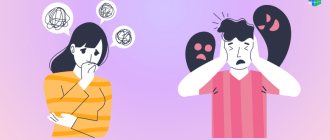Intrusive thoughts or “mental chewing gum”
Kubareva Svetlana Vladimirovna
Psychotherapist
June 25, 2016
“What you can perceive calmly no longer controls you” Confucius
It is difficult to find people who have not encountered obsessive thoughts . These thoughts arise against your will, spin in your head for hours like a “broken record” and are always emotionally charged. It’s not for nothing that they are called “mental chewing gum ,” because they are just as sticky, viscous and lead absolutely nowhere.
For example, you talked to someone in a raised voice and became agitated. The situation ended a long time ago, but you continue to mentally replay it: “you should have said this and that, done such and such...”. You get angry, argue, find more and more evidence that you are right, and just can’t calm down and switch...
As a result, nothing changes, while fatigue sets in and the only desire appears - to get rid of thoughts at any cost. But that was not the case... Because all manifestations of obsessions hide emotions, which quite often are not reacted to in a stressful situation. You are seething with indignation, you are very afraid or worried about the future, or maybe you are just incredibly offended... And until you cope with your emotions, live through them, you will not be able to free yourself from the thoughts that are haunting you.
who are responsible, prone to perfectionism , and have a characteristically anxious and suspicious radical personality often suffer from “mental chewing gum.” As a rule, they initially have the habit of constantly conducting an internal virtual dialogue. Moreover, these are people with clear rules and guidelines, the truth of which is beyond doubt. Such conversations “to oneself” over time arise not only in situations that are emotionally important for a person, but also relate to any everyday things. Gradually and imperceptibly, a person loses his freedom and becomes a hostage to an obsessive state.
Obsessions can also be a manifestation of a more serious, painful condition. Suddenly my heart began to pound, I felt fear, anxiety, and the thought arose: “there’s something wrong with my heart, what if I die like my grandmother, who suffered from heart disease...”. A person becomes fixated on a symptom, is afraid of it, begins to surf the Internet in search of information about his imaginary disease, constantly listens to himself and, of course, finds more and more new confirmations, the fear intensifies...
Then he moves on to action: he begins to undergo examinations, visit specialists, and although all the test results are normal, there is no relief. As a rule, all this is accompanied by anxiety and depressive symptoms, performance is impaired, it is difficult to concentrate, and insomnia occurs. And then we can talk about OCD (obsessive-compulsive disorder) or obsessive-compulsive disorder.
Can obsessive thoughts be useful?
If a bank loan has been issued to you, the time for the next payment is approaching, but there is no money... Then thoughts about where to get the necessary amount will stimulate you to look for a way out of the current situation.
Or, let’s say, you have a goal - to buy an apartment and you are looking for possible options, you sit for days and monitor prices, compare and analyze, collect information about developers so as not to make a mistake in choosing a company.
Or, you really want to improve your relationship with your partner. To do this, you read a lot of specialized literature, attend trainings, take care of yourself, constantly think and analyze “what and how” it should be….
As a result, if this situation continues for a long time, there may come a time when you decide to take a break, try to switch and occupy yourself with something else, but notice that you still continue to unconsciously think about your goal.
The very occurrence of an obsessive state is dangerous and harmful to us - it is a sign that mental problems have begun. And we urgently need to take action.
There is only one conclusion here - it doesn’t matter how valuable and useful what you do is! You must always take breaks, stop and allow yourself to rest emotionally, physically, and especially mentally, otherwise everything can end badly. Intrusive thoughts that are repeated endlessly are not productive. They only torment and take away energy. And, ultimately, they lead to illness. Therefore, you need to get rid of them.
How to help yourself:
Don't believe in your thoughts! - you need to realize the fact that you cannot completely believe everything that comes to your mind. Our thoughts are not us. Most thoughts are automatic, arise without our desire and 80% are repeated day after day in different variations. Let these thoughts be in your head, allow them to be and observe them. You don't have to believe in them. Your indifference and calm attitude towards these thoughts will significantly reduce their emotional intensity.
Don't resist them! — you cannot fight obsessive thoughts or try to get rid of them. Just indifferently start ignoring them, since there is nothing new or useful in them. Imagine that you have watched this movie hundreds of times and know all the details by heart. Are you interested?!
Find peace of mind! – obsessive thoughts feed on experiences, so rational arguments will not help you. It is important to deal with emotions and imagine yourself as an outside observer who indifferently watches what is happening. To do this, learn to switch. Any method will do: chatting with friends, an interesting book, an exciting movie, sports training or spa and relaxation; meditation techniques also work well.
I recommend! Take care and maintain your mental health. Take time to rest, eat right, try to move more and be outdoors. Give yourself as much joy as possible. Let only good positive thoughts live in your head.
Obsessive actions and thoughts: how to get rid of them?
ObsessionsOCDFearAnxiety
Obsessive thoughts or actions - also called obsessions and compulsions - are one of the most complex disorders. In addition to the actual time it takes to perform obsessive actions and “thinking” about obsessive thoughts, the person also experiences difficulties in communicating, working, studying, or in general in everyday life.
Minor obsessions or behaviors are familiar to everyone: we may be preoccupied with thoughts about an upcoming important event, such as an exam, we may worry about whether we have turned off the stove, we may avoid stepping on cracks in the pavement, and we may follow a certain routine every morning.
All this helps reduce anxiety and relieve tension. 40% of people feel irritated when they have to change the routine.
Some obsessive thoughts or ideas may even be useful in life.
Some time ago, I already published a list of obsessive thoughts that come to the minds of quite normal people, based on a survey on Facebook and according to data from the literature. Look at the picture: these are actions that many people intentionally perform (according to research by Muris, Murckelbanch & Clavan, 1997).
Here is a continuation of the list of obsessive thoughts in normal people.
However, in some cases, the frequency of intrusive thoughts becomes greater, and it becomes increasingly difficult to resist the impulse to perform a certain action.
Here is an example of how much obsessive-compulsive disorder can ruin and complicate the life of an ordinary person.
A case of obsessive thoughts about cheating
She worried more and more often that she would cheat on her husband. Maybe she even somehow unwittingly cheated on him?
A 26-year-old girl, let's call her S., dated a young man for a long time, finally he proposed to her and she agreed. Around this time, she first had a “strange” thought and anxiety that she might cheat on her future husband. Despite the fact that she did not have the slightest desire to do this, and she had never done this before, these fears were firmly lodged in her head, and, as the wedding day approached, S. became more and more worried , whether she will cheat on her husband. Maybe she even somehow unwittingly cheated on him? These thoughts caused her great discomfort; she could hardly escape from them.
Before this incident, S. periodically worried that she might harm other people: for example, when she bought a set of tableware, she thought that theoretically she might not be able to resist and unwittingly cut someone in her household with a knife, after which these thoughts began to constantly return to her. In general, S. considered herself a very polite and well-mannered girl with a gentle character, she had never had any problems with the law, and therefore these terrible thoughts frightened her very much.
In addition, S. felt guilty for having such thoughts. Therefore, she decided to take a number of measures for protection: for example, she removed the knives from the set and put them away in a cabinet with a lock; she avoided setting the table before dinner; she stopped leaving the house alone to completely eliminate the possibility that she would “impulsively” start flirting with other men.
After some time, she came up with the idea of starting to keep a special diary, where to write down where and with whom she was throughout the day from the moment she woke up until she went to bed, in this way S. could prove to herself that she had definitely not cheated on her husband and did not harm other people. She allowed herself not to keep a diary only if she was with her husband or with one close friend.
After some time, S. asked this close friend if she had heard any rumors that S. was cheating on her husband. A little later, S. began to be constantly interested in this topic, not only when communicating with a close friend, but also when communicating with other people.
And a little later, S. found herself carefully watching the news on TV in the hope that her name would not be mentioned in reports about crimes.
Her future husband could not help but notice this; he was very upset and saddened by what was happening. Of course, he was worried that S. was constantly talking and thinking about cheating on him. Also, these phenomena greatly interfered with S.’s own life, communication and work.
Features of obsessive thoughts and actions (obsessions and compulsions)
Is dust full of germs or not?
Compulsions, or obsessions , are far from just excessive worry about problems, and compulsions (obsessive actions) are not simple repetitive movements. The peculiarities of obsessions lie in the fact that a person perceives them as foreign, intruding, sometimes even contrary to his nature, excessive, senseless, but... they cannot do anything about them. Each time they return, the person experiences great anxiety.
Obsessions come in the form of:
- desires (the desire for the death of a spouse, for example);
- impulses (the impulse to swear in church);
- images (forbidden, unwanted images of scenes of a sexual or violent nature);
- ideas (microbes everywhere);
- doubts (closed or did not close the door).
Typically, obsessions contain one or more recurring themes, and the most common of these are contamination and dirt. Other “popular” obsessional themes are violence, aggression, neatness, symmetry, order, religion and sexuality. Typically, obsessive thoughts in normal people occur on exactly the same topics.
All people have strange thoughts about germs or an unlocked door, but some people think that this is not normal.
Separately, it is worth noting the obsessive feeling of “not good enough” (incompleteness). In this case, people may turn lights on and off several times or move objects from place to place until they feel that “now is good enough.” Unfortunately, “good enough” is becoming more and more difficult to achieve.
To get rid of obsessions, people suffering from obsessive-compulsive disorder feel an irresistible need to perform certain obsessive actions, or compulsions, also known as rituals . Despite the fact that a person understands “with his mind” that performing this action is irrational and pointless, he still performs it and feels relief. For a while. Compulsions can also take many forms, with the most common ones being cleansing, washing, checking, and organizing.
Other compulsions may be expressed in certain “defensive” words, counting, “special right thoughts,” prayers, and other attempts to neutralize or “cancel” the obsessive thought.
Obsessive thoughts and actions (rituals) are directly related to each other. Rituals allow you to reduce anxiety from an obsessive thought (or image, etc.). However, if, in essence, there is nothing dangerous in obsessive thoughts, then rituals are not so innocent.
We can say that the lion's share of the contribution to the maintenance of obsessive-compulsive disorder belongs to rituals. The second reinforcing and strengthening mechanism is avoidance : situations and events that can provoke obsessive thoughts or actions.
Other disorders similar to obsessive thoughts
It is necessary to distinguish obsessive-compulsive disorder from other conditions that are very similar to it, for example, trichotillomania, kleptomania, nail biting, tics, etc. For example, with trichotillomania (hair pulling), there are also repetitive and obsessive actions, but obsessive thoughts that cause alarm, absent.
People with obsessive-compulsive disorder perform actions out of fear of infection, anxiety about doing something wrong, and double-check themselves to make sure that the worst thing has not happened or will not happen. In contrast, those suffering from trichotillomania experience a strong urge to pull out their hair due to unpleasant feelings (boredom, anger, frustration, etc.). In addition, after performing an action, patients with trichotillomania often feel pleasure, but with OCD there is no pleasure.
In addition, the specialist differentiates the diagnosis from schizophrenia and delirium.
Cognitive-behavioral psychotherapy for obsessions
During ERP, the client may be asked to touch “particularly dirty” objects.
So, how can you get rid of obsessive thoughts and rituals ? Firstly, I’ll say right away that only a doctor (a psychiatrist, for example) can make a diagnosis of obsessive-compulsive disorder. Secondly, obsessions in adults can be treated both with medication and psychotherapy. As a rule, antidepressants are prescribed, and in some cases antipsychotics. Only a doctor should prescribe medications!
In addition, the following methods are widely used: ERP (exposure and response prevention) and cognitive psychotherapy .
ERP (exposure and response prevention) - or immersion and response prevention - is a behavioral technology that essentially consists of the following: a patient with obsessive-compulsive disorder, together with a psychotherapist, compiles a list of obsessive fears, after which the patient will deliberately immerse himself in an alarming situation and not Give yourself a ritual to relieve anxiety. The psychotherapist acts as a trainer or coach who, using ERP technology, helps the client complete this task and supports and guides him.
There are a lot of ERP options, they are created individually for each specific client. Only the general scheme of ERP implementation remains the same. So, for example, a person who has obsessive fears of infection may be asked to touch “especially dirty” objects (door handles, toilet, floor, etc.). Naturally, such a task causes an increase in anxiety and an increased desire to perform an obsessive ritual (washing your hands). However, since performing the ritual is impossible, the person fights the fear in his imagination. By repeating this task, anxiety decreases significantly, because this is our physiology. This process is called habituation. The next time, addiction comes faster and easier. As a result, a significant reduction in the number of obsessions and compulsions is achieved.
Cognitive psychotherapy allows you to identify the main fears and incorrect beliefs that provoke obsessive thoughts. The therapist explains to the client that intrusive thoughts are generally normal, and then typical cognitive processing of core beliefs is carried out. Special emphasis is placed on preventing avoidance. This type of psychotherapeutic intervention complements ERP well.
ERP holds the lead in the effectiveness of treating obsessions, compared to other types of psychotherapeutic assistance: individual cognitive psychotherapy, therapy for obsessions in the imagination, etc. According to research by Foa & Kozak, up to 70-80% of people who have completed an ERP course feel improvements. If we compare the effect of ERP and drugs, the effect is the same. However, ERP plus medications does not provide any benefit.
Instead of an afterword
If you are reading this article because you have obsessive thoughts or behaviors, know that there is help available today and you are not alone. Obsessive-compulsive disorder is a very unpleasant thing, but you can get rid of it. If you have questions, write to me and come to a consultation with a psychologist about the symptoms of obsessive-compulsive disorder.
Provided by SendPulse
Types of intrusive thoughts
Any recurring anxious thought can become intrusive. However, researchers have divided intrusive thoughts into several main subtypes:
- Thoughts of violence: obsessions with harming oneself or others.
- Thoughts about relationships: obsessions related to doubts, fears or compatibility in (intimate) relationships, thoughts about the other person and the relationship with him in general.
- Religious Thoughts: Obsessions related to morality, ethics, and potential blasphemy in a religious context.
- Sexual thoughts: obsessions related to sexual orientation or deviant sexual behavior.
- Contagion thoughts: Obsessions about being infected by germs, viruses, or diseases.
- Thoughts about responsibility: Obsessions about whether certain actions or inactions directly affect others and whether they create any risks.
- Other obsessions.
Some of these obsessions may begin as mild anxiety. However, over time they turn into painful attempts to overcome them.
Anxiety and fears: how to overcome. Recommendations from experts.
Anxiety and fear are natural emotions that nature has endowed humans with. In a difficult situation, they help him, mobilizing physical and mental resources, and in a moment of danger they can even save his life. But in some people these negative states appear as if for no reason. In fact, there is a reason, it’s just hidden deep in the subconscious. For example, people who have experienced serious difficulties or severe shocks begin to fear that a similar situation may happen again in the future.
When a person begins to worry or fear something, he experiences not only negative emotions, but also certain physiological reactions. His muscles tense, his heartbeat and pulse quicken, he feels chills and lack of air in his chest. Hands begin to tremble, sweating increases. At the same time, obsessive thoughts swarm in your head, your imagination draws all sorts of unpleasant pictures, increasing the feeling of anxiety.
It is often difficult for a person to determine exactly what emotions he is experiencing. Anxiety is characterized by an unpleasant painful sensation in the chest, in the heart area, and the expectation of trouble. Fear puts you into a state of panic, in which a person’s rational thinking is turned off. He cannot sit down calmly and analyze the situation, he is simply afraid and panicking.
If the experiences do not leave a person for a long time, his appetite worsens or completely disappears, his sleep becomes superficial and intermittent, he wakes up at night and cannot fall asleep for a long time. For some people, on the contrary, their appetite increases, and they try to “eat up” their negative emotions. A state of chronic stress takes away strength, so a person feels exhausted and tired. All this cannot but affect his life. If you do not get rid of the feelings of fear and anxiety in a timely manner, there is a danger that they will develop into a real mental disorder. Therefore, psychologists advise learning to cope with negative experiences on your own.
Almost every person is capable of overcoming fears and anxiety, negative emotions and experiences. It's not as difficult as it might seem at first glance. You just need to set a goal and follow the advice of psychologists. The most effective recommendations from specialists that can be used at home.
· Identify the cause of your worries. If you want to get rid of anxiety and worry, be sure to find the cause. Think about what kind of situation scares you. Maybe you're afraid of heights, crowds, talking to strangers, or speaking in front of an audience. Remember when your fear first appeared, in what situation it happened.
· Don't hide from your fear, don't deny it. If you honestly acknowledge its presence in your life, it will become easier to deal with it.
· Learn to relax. Anxious states force you to be in constant tension, take away your energy and strength. Therefore, it is very important to learn to relax. To do this, you can use any method: a warm bath, a walk in the park, an evening jog in the fresh air, yoga or meditation, breathing exercises, listening to pleasant, soothing music. Try to distract yourself from the experiences that torment you and devote yourself to your chosen activity.
· Discuss your fears with a loved one. There is nothing better than sharing your worries with someone you trust. This could be a close relative or friend to whom you can open your soul. Tell us what worries and concerns you and listen to your interlocutor’s opinion. Very often, after such a conversation, a person begins to treat his problem more calmly, and his feelings lose their severity.
· Put your thoughts on paper. If you don't have someone you can trust, don't despair. Keep a diary and write down all negative experiences there. This will make it easier for you to understand yourself and understand what exactly worries you and in what situations fear manifests itself most strongly.
· Laugh and smile more often. Bring more humor into your life. Watch comedies or comedy shows, read jokes, look for various funny jokes on the Internet. It's good to do this in the company of friends. This way you can have a good laugh, relieve stress and forget about your worries for a while.
· Don't sit idle. When a person is not busy with anything, negative experiences begin to attack him, and gloomy thoughts swirl in his head and do not allow him to relax. The best thing to do in such a situation is to get down to business. Do whatever you want: clean the apartment, cook a delicious dinner, pay attention to your husband or wife, play with your child, go to the store.
· Allow a certain amount of time for fears and anxiety. Most likely, you will not be able to constantly keep your feelings under control. There is no need to do this. Set aside 20-30 minutes for them every day. At this time, let your imagination draw the most terrible pictures. Give free rein to your anxiety, give in to it completely. Don't analyze your emotions, just experience them. When the allotted time is up, return to your normal activities. If anxiety starts to overcome you during the day, just write down the thoughts that are bothering you on paper, and you can worry about it in the allotted time.
· Don't dwell on the past . If you have had unpleasant situations in the past that caused internal fear or anxiety, your thoughts may often return to these events. Don't let them do this. The past has already passed and it is not at all a fact that the negative scenario will happen again. Relax, calm your nerves and live in the present moment.
· Don't plan your actions in advance . Usually, before an important event, people think through their every step, rehearse their actions and words. If you are very anxious, then let your actions be spontaneous. Very often they turn out to be much more effective than planned. Trust the situation and act according to the circumstances.
· Don't feed your fears . If you have a tendency to worry excessively, try to avoid reading or watching news, crime reports, and other information on TV as little as possible, which will only aggravate existing fears and create fertile ground for the emergence of new ones.
· Change your eating habits . Some foods we eat tend to aggravate anxiety. This includes tea, coffee, alcohol. Reduce the amount of these foods in your diet or eliminate them altogether. By the way, excessive indulgence in sweets also increases anxiety, because when blood sugar rises, a person develops an unreasonable feeling of anxiety.
· Communicate with people . If you feel anxious, don't sit alone. Go to a crowded place - a cinema, theater, concert or exhibition. Meet with friends more often. Give preference to live communication, but if this is not possible, do not neglect conversations on the phone, Skype, or correspondence on the Internet.
If all of the above methods of dealing with anxiety do not produce results, it is best to seek help from a psychologist or psychotherapist. Often the roots of increased anxiety lie so deep in the subconscious that a person cannot find them on his own. The task of a psychologist is to help a person understand the causes of fear, remove them from the subconscious and teach him to overcome anxiety. A specialist will help you deal with your fears and give useful recommendations.
Obsessive-compulsive neurosis - symptoms and treatment
Psychoanalytic theory. According to Freud, obsessive thoughts arise from the suppression of aggressive and sexual drives. These symptoms develop as a result of regression to the anal stage (the second stage of psychosexual development according to S. Freud, which begins at the age of 18 months and ends by three years) [7]. Regression depends on one of the following factors or a combination of them:
- defensive ego;
- residual phenomena of the anal-sadistic stage of development;
- phallic organization [3].
There was no objective evidence in the stated theory, so only some scientists consider it possible to consider it as an explanation for the cause of OCD.
Neurochemical theory. This theory was put forward by I.P. Pavlov; it is based on the role of acetylcholine and adrenaline metabolism [14]. Further, the occurrence of OCD has been described as a result of disturbances in serotonin metabolism.
The evidence was a comparison of the effectiveness of serotonin reuptake inhibitors, non-serotonergic drugs and placebo tablets in OCD. Strong correlations between plasma levels of clomipramine (an antidepressant) and reduction in OCD symptoms further supported the role of serotonin in the development of this disorder. However, the study of serotonin metabolism in OCD patients has not yet been sufficiently effective. Contrary to this theory, clomipramine is in some cases better at reducing OCD symptoms than selective serotonin reuptake inhibitors such as fluoxetine, fluvoxine and sertraline [4].
Neuroanatomical theory. Based on the results of special studies, neuroanatomical justifications for OCD were obtained. Frontal lobe dysfunction has been identified in many patients with OCD, but only a few researchers have been able to confirm this. Additional evidence for the involvement of the frontal lobe in the development of OCD has been the use of effective psychosurgical techniques such as capsulotomy and cingulotomy (targeted damage to brain structures whose activity causes the disease).
Evidence of neurobiological disorders in OCD is the connection of this disorder with another pathology, which is based on processes in the basal ganglia (lethargic encephalitis, Sydenham's chorea and Gilles de la Tourette's syndrome). Also, based on the results of four studies that assessed the metabolic activity of the brain using positron emission tomography, it was proven that metabolism in this disorder is increased in the prefrontal cortex [4].
Intrusive Thoughts: Link to Anxiety Disorders
There are several types of anxiety disorders that involve obsessive thoughts:
- Most often, intrusive thoughts are a manifestation of obsessive-compulsive disorder, in which obsessions can take the form of unwanted thoughts, images, or impulses. They appear regularly and to suppress, neutralize or control obsessions, people use obsessive actions (compulsions).
- Generalized anxiety disorder: excessive worry and worry in a variety of situations. Obsessive thoughts can relate to many areas of life, including family relationships, professional sphere, health, environment, etc.
- Panic disorder: recurrent panic attacks, fear and obsessive thoughts about when the next panic attack will occur.
- Social anxiety disorder (social phobia): Intrusive thoughts relate to others' perceptions and judgments of the person with obsessions.
- Specific phobia: the experience of anxiety focused on a specific situation, object or thing. Intrusive thoughts are related to security and the perceived threat of its violation.
- Separation anxiety disorder: the experience of anxiety due to the loss of a close relationship with a significant other. Intrusive thoughts are associated with the loss of another person.
- Agoraphobia: the experience of an intense fear of being in certain places or environments, such as enclosed spaces or large crowds of people. Intrusive thoughts are related to safety and well-being, as well as the fear of being trapped or physically harmed.
In addition, intrusive thoughts may co-occur with other mental disorders such as depression ; postpartum depression ; substance use disorders; eating disorders . In this case, obsessive thoughts partially authorize the behavior associated with a mental disorder. Thus, the person remains in a constant cycle of cognitive distortions and harmful behavior.











